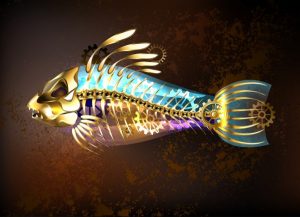Space is often considered the ‘final frontier’. Satellites have played a big role in the exploration of space as they send data back to scientists here on earth. However, the oceans of our home planet remain largely unexplored. The age of underwater robots is here. Researchers have developed a kind of satellite for the oceans – autonomous miniature robots that can work as a swarm to explore oceans in a new way.
These propeller-free underwater robots may soon be swimming with style. A new model of how fish and other aquatic species are able to propel themselves forward without expending much energy may help create energy-efficient robots that swim just much like sea creatures. 
Mehdi Saadat at Harvard University and his colleagues have been closely studying and monitoring how fish, dolphins and other sea creatures swim. They have found that many of them have remarkably similar styles that can be described with a simple model, depending on how fast and far the tail whips back and forth, and the length of the animal.
When developing other underwater robots, scientists had previously studied one parameter that related the beat of an oscillating fish’s tail and how far it oscillates to the animal’s forward motion. It turns out, it’s a bit more complex than simply the beat. How far the tail goes to and fro; relative to the fish’s length is a second important factor.
Deploying robotic sea creatures can help scientists understand and monitor changing ocean currents, study the habits of different sea creatures and understand underwater plant life. Using underwater robots that move like the fish around is less likely to disturb the natural habitat, thereby allowing researchers and scientists to get a clearer understanding of the sea.
Not only can robotic fish help us understand the depths, but they may also be an unlikely ally in the fight against antibiotic resistance. Swimming through streams and lakes, it will monitor the levels of antibiotics in the water, among other pollutants. The prototype will soon be sent below the surface of the lakes near Michigan, which are under threat from industrial pollution and contaminants from farming.
“The idea is to put sensors on the robots so that you can gather data from different locations in an automated manner,” says Xiaobo Tan at Michigan State University. By understanding the antibiotic levels in different parts of the lake, it should be easier to work out where they are coming from.
At Universe Optics we work closely with manufacturers in the design of precision lenses. Employing our services in the manufacture of a lens for an underwater robot will guarantee precise details from design through final manufacturing, ensuring the clearest image possible in the depths below.
The rules employed in the exploration of the depths of the sea, and monitoring toxins of lakes and streams is just the first step with underwater robots. The ability to build robots that move underwater without a propeller can be used not only in oceanography, but also within the confines of the military, disasters at sea, and other modalities where not disturbing the waters would be beneficial.